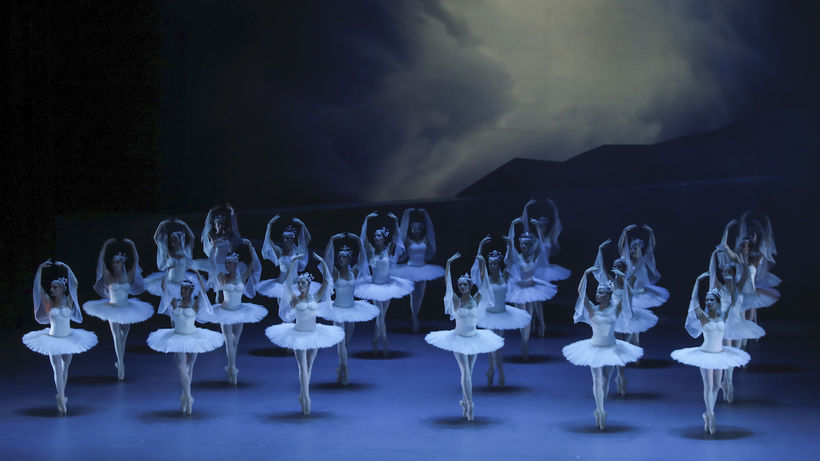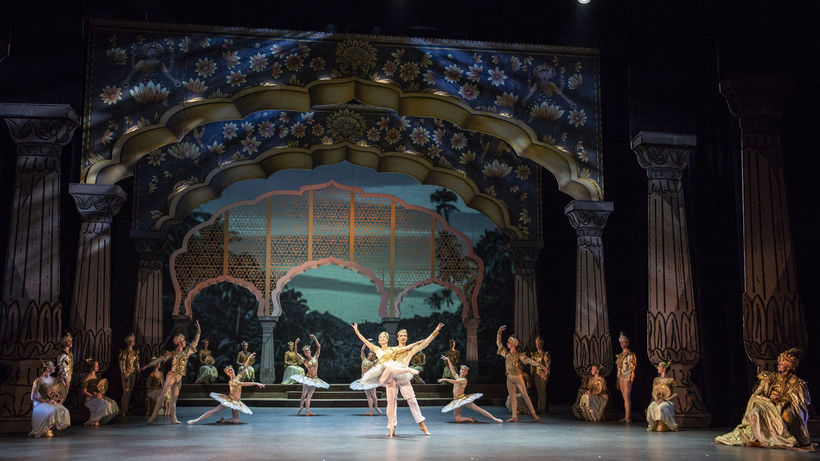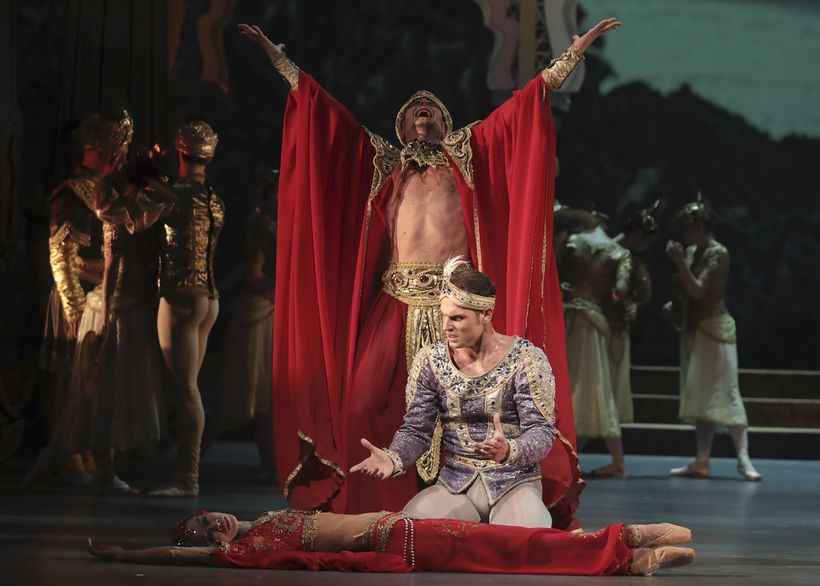La Bayadère is one of the most celebrated works by Marius Petipa (apart from Tchaikovsky’s triumvirate The Sleeping Beauty, Swan Lake and The Nutcracker) who presented the ballet to the music by Ludwig Minkus at the Mariinsky Theatre (the then Imperial Bolshoi Kamenny Theatre) in St Petersburg in 1877. Petipa revisited the ballet in 1884 and 1990, and later it was revived by Alexander Gorsky (1904 and 1917) and Agrippina Vaganova (1932). The canonical and most celebrated version was created by Vladimir Ponomarev and Vakhtang Chabukiani, premiering in Leningrad in 1941. It was this staging of La Bayadère, to which contributed such choreographers as Sergei Legat (the adagio of Solor and Nikiya and Solor’s variation from the Kingdom of Shades), Constantin Sergeiev (1947, the duet of Nikiya and Slave, music by Césare Pugni), and Nikoli Zubkovsky (1948, the Golden Idol variation), that has inspired many creators since, including Jaroslav Slavický. However, the names of all co-authors are hardly ever cited, and the overused phrase “after Petipa” is preferred in the ballet world instead. An easier solution of course, but much less correct and fair.
The story of the temple dancer Nikiya, the warrior Solor and rajah’s daughter Gamzatti is set in exotic India and was inspired by the ballets God and the Bayadère (Filippo Taglioni, 1830) and especially Sacountala (Lucien Petipa, 1858). The original, pre-revolutionary Russian version was staged in four acts and seven tableaux - I. Rite of the Fire, II. Two Rivals and Death of Bayadère, III. Entrance of the Shades, The Kingdom of the Shades and Solor’s Awakening, and the final IV. Gods’ Revenge. After the Bolshevik coup d’état, the ballet went through substantial changes. The final part was left out completely, as it did not conform with the new political regime and was technically too demanding, due to elaborate stage effects. In addition, extensive fires destroyed the original sets. The story thus ended in the dream-like world of the shades, until Natalia Makarova’s 1980 production for the American Ballet Theatre tried to resurrect the original ballet including the canonical wedding of Gamzatti and Solor and the destruction of the temple by raging gods (Act Four).

However, the Kingdom of the Shades became an independent showpiece which mesmerized audiences by the celebrated entrée of female dancers on stage – thirty-two ballerinas appear on the horizon and descend on the stage in a hypnotising series of steps, low arabesques and slight cambrés (in 1900, there were 48 members of the corps de ballet and during the scene, they did forty arabesques). In the West, the scene was staged for the first time by Nikolai Sergeiev in Paris in 1927, with Olga Spesivcevova as Nikiya. In 1961, the scene was performed by the Kirov Ballet dancers during their tour.
The libretto was written by Marius Petipa himself, many sources also refer to Sergei Khudekov as the co-author, though his real contribution is a matter for debate. Jaroslav Slavický decided to reshape this libretto and although the changes seem to be subtle and not radical, the logic of the story (which has suffered insensitive modifications during the 20th century) and its dramaturgical structure were much affected. The characters’ motivation is inconsistent, and their actions do not make sense ( in the final scene of the ballet, for instance, the Highest Brahman forcefully joins the hands of Solor and Gamzatti and causes a disaster he warned about two acts earlier).
New ideas that could possibly lead to sharper definitions of the characters, show them in a different perspective and bring the much-needed nuances, have been left unused, as if the author recoiled from presenting his own opinion. Personally, I can see this tendency in the character of Gamzatti, who, at best, seems to be sort of bipolar, but you cannot identify with her, sympathise with her, no matter how hard you try. On the other hand, Solor’s character is reduced to the bare minimum, which raises the question: ‘How can anyone without a moral “spine” and a solid attitude even survive, not to mention hunt down a tiger during the opening scene (and with a bow!). Nevertheless, I must appreciate the use of pantomime scenes (into which dance passages have been integrated, probably to achieve a dramatic effect). They are built on a solid, meaningful basis and are easy to understand (although the vow gesture should be done with an open hand, the other one placed on the heart to make it clear what the promise is about).
As far as the structure of the ballet is concerned, many parts have been omitted, which is especially obvious in the 2nd act celebration of Solor’s engagement to Gamzatti, and in the final act which has become more of a short coda. The series of multiple variations, duets, solos and corps de ballet scenes, typical of the 19th-century ballet-féeries, may easily become an unbearable procession for today’s spectators. The architecture of a reduced act (ideally not making the impression of a bare-bone structure), should still retain its coherence and gradation. Otherwise, it might happen that the elegant classical opening is inappropriately followed by Danse infernale (Dance of the Indian Warriors). Choreography-wise, Jaroslav Slavický (like many others) refers to Petipa’s genius and pays homage to the famous creator by including Chabukiani’s Grand Pas and Nikiya’s monologue.

The costumes and sets have been created by Josef Jelínek ad Marek Hollý, respectively. Jelínek’s costumes are not surprising, they bring the expected opulence and dazzle. They meet the standards of a big narrative ballet. Hollý’s scenography, by contrast, is a wild, dysfunctional mix of psychedelic canvases in Solor’s chambers, a photorealistic explosion behind the windows of Rajah’s palace, and levitating pillars (resembling Miloš Nesvatba’s illustrations) marking the destruction of the temple.
As one of the most brilliant ballets, La Bayadère requires a high level of dance technique and virtuoso performances of the soloists as well as the corps de ballet. During the première, the quality of performances went up and down, and in Act Two the level of dance dropped considerably. The impression was improved by the focused performance of the Shades whose entrance, though lacking the ethereal lightness and being too mechanical at times, did not show any bigger mistakes. The three solo Shades in Act Two excelled as well, most notably Dilyana Yaneva in the 2nd Shade variation.
The female protagonists, whose conflict forms the basis of the ballet, were portrayed by the first soloists Eriko Wakizono (Nikiya) and Ivona Jeličová (Gamzatti). Wakizono’s Bayadère was gentle and fragile, the role would deserve to be better defined, though.

Jeličová’s stage presence was, undoubtfully, very charismatic, though the development of her character was questionable, and she struggled in purely balletic passages. The main star of the première was Michal Krčmář, a graduate of the Dance Conservatory of the City of Prague and current first soloist of the Finnish National Ballet. We cannot deny his gracefulness and high jumps, as well as we cannot ignore his empty gestures, helplessness and strange mannerism. To me, it seemed like his dancing was harmed and lost its splendour, intensity, and relevance. Attempts at redressing canonised models and inconsistent staging approaches are the main downsides of Brno’s La Bayadère. A 2019 production thus feels like an outdated piece, which only encourages the false belief that classical ballet is a stiff art form full of illogical and naïve tales. In terms of outdatedness, it does matter when a premiere takes place or from which sources it takes, what is really important in the approach, staging ideas and high-quality execution.
In the booklet programme to the performance, Jaroslav Slavický notes that a production aiming at reviving the original version of La Bayadère could harm the title, as we lack “the awareness of the ballet tradition.” As a dance historian, who focuses on the 19th-century ballet heritage, I cannot imagine an author who would try to reconstruct a ballet without consulting all available sources to reach as much information on the period traditions as possible and get an in-depth understanding of the piece. That is why such performances are called historically informed. One of the most apt examples can be Alexei Ratmansky’ La Bayadère which premiered in Berlin earlier this year (more information here). From the position of a spectator, its aesthetic framework can be approached in many different way, but I dare say this Berlin production did little harm to the original ballet masterpiece.
Written from a revived première held on 18 October 2019, at Janáček Theatre, Brno.
La Bayadère
Choreography and direction: Jaroslav Slavický after Marius Petipa
Libretto: Marius Petipa, Sergei Khudekov, Jaroslav Slavický
Music: Ludwig Minkus
Music libretto: John Lanchbery
Conductor: Pavel Šnajdr
Set design: Marek Hollý
Costume design: Josef Jelínek
Revived première: 18 October 2019 (first staging 11 April 2003)
Translated by Tereza Cigánková.







